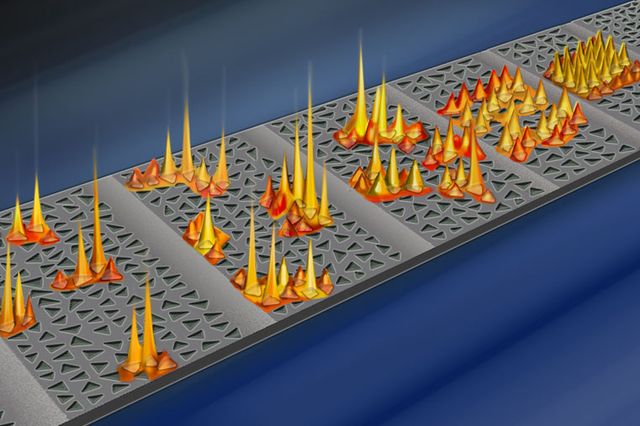 Artist’s depiction of light traveling through a photonic crystal superlattice, where holes have been randomly patterned. The result is a more narrow beam of light. Credit: Nicoletta Barolini
Artist’s depiction of light traveling through a photonic crystal superlattice, where holes have been randomly patterned. The result is a more narrow beam of light. Credit: Nicoletta Barolini
Researchers from Columbia University, UCLA and other institutions have conducted a study on controlling the light at very small wavelengths of around 500nm, smaller than the wavelength of light itself, using random crystal lattice structures as a means of preventing the diffraction of light. This research could enable precise transfer of information in new optical materials for lasers and light emission, and computer chips, paving the way for advancement in laser collimation field.
When considering the example of light radiated from a flashlight, diffraction takes place as the light travels from the flashlight to the wall. The farther the flashlight is held, the more the beam diffracts as it approaches the wall. Similar phenomenon can occur on a small scale, say nanometers, which are equivalent to one-billionth of a meter. For instance, it is possible to use light for transmitting information in optical fibers and computer chips. This information may not be delivered properly or clearly when the diffraction occurs.
Therefore, technology that counteracts diffraction and facilitates precise control of light carrying data could lead to developments in the field of optical communications. This could also help avoid taking into account the physical limitations of optical signal processing in existing electronics, allowing engineers to produce enhanced optical fibers ideal for biomedical applications.
The researchers employed a photonic crystal superlattice made of light-transmissive crystals, in order to control light transmission at the nanoscale. The lattice was arranged in a disordered pattern with a number of nanoscale triangular, square and heptagonal holes. These holes that are smaller than the wavelength of light transmitted through the structure act as guideposts for a light beam.
It is a known fact that the uniformly patterned holes are capable of regulating the spatial diffraction in the crystal to a certain extent. By contrast, through this study, the researchers observed that the structures with disordered pattern can confine the light beam and collimate the beam to a narrow path. Such a structure can be produced over a wide range of infrared spectrum.
The principal investigator of the study was Chee Wei Wong, associate professor of electrical engineering at the UCLA Henry Samueli School of Engineering and Applied Science. It was published in the journal Nature Physics. The study was led by Pin-Chun Hsieh who worked under Wong, while doing his doctoral studies at Columbia University’s Fu Foundation School of Engineering and Applied Science.
In 1958, Nobel laureate Philip Anderson proposed the effect of disorder, also called Anderson localization that describes the conductance between the electrons and waves in condensed matter physics. This new study is the first-ever study to analyze transverse Anderson localization in a chip-scale photonic crystal media.
This study allows us to validate the theory of Anderson localization in chip-scale photonics, through engineered randomness in an otherwise periodic structure. What Pin-Chun has observed provides a new path in controlling light propagation at the wavelength scale, that is, delivering structure arising out of randomness.
Chee Wei Wong
According to Hsieh who is the chairman and majority owner of Taiwan-based Quantumstone Research, the results are completely counterintuitive as the disorder in the structures might cause the light to diffract more. “This effect, based on intuition gained from electronic systems, where introduced impurities can turn an insulator into a semiconductor, shows unequivocally that controlling disorder can arrest transverse transport, and really reduce the spreading of light,” he said.
The researchers carried out numerical simulation at University College London, and sample fabrication at National Cheng Kung University in Taiwan and the Brookhaven National Laboratory in New York.
The research received its primary support by the U.S. Office of Naval Research. Additional support was given by the government of the United Kingdom and the National Science Foundation, the Department of Energy.
References